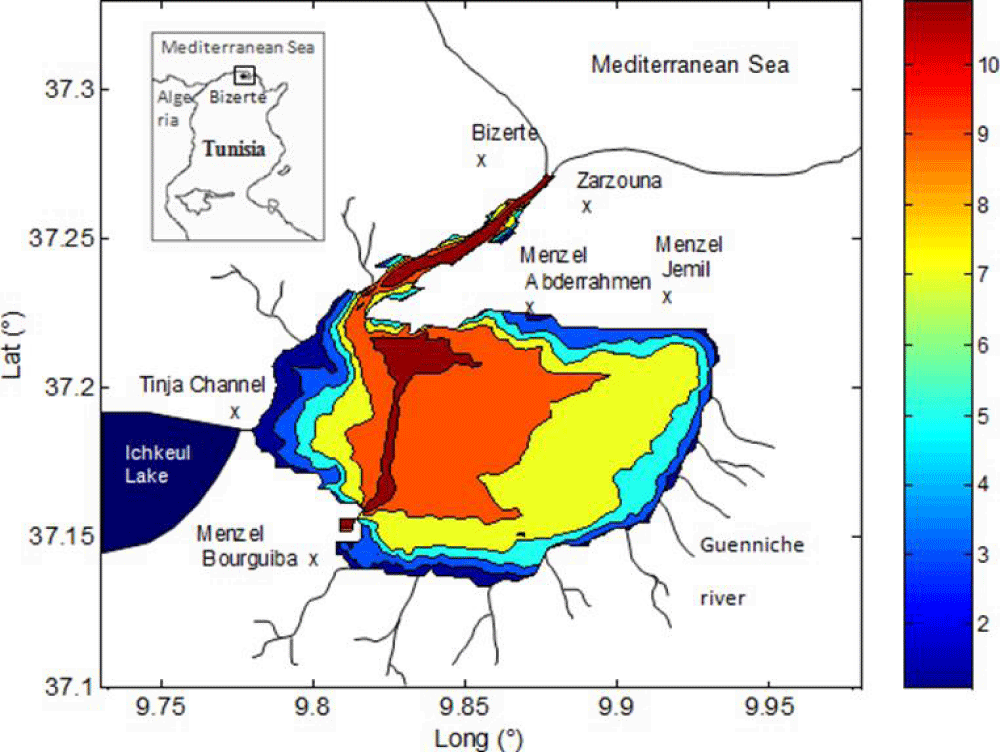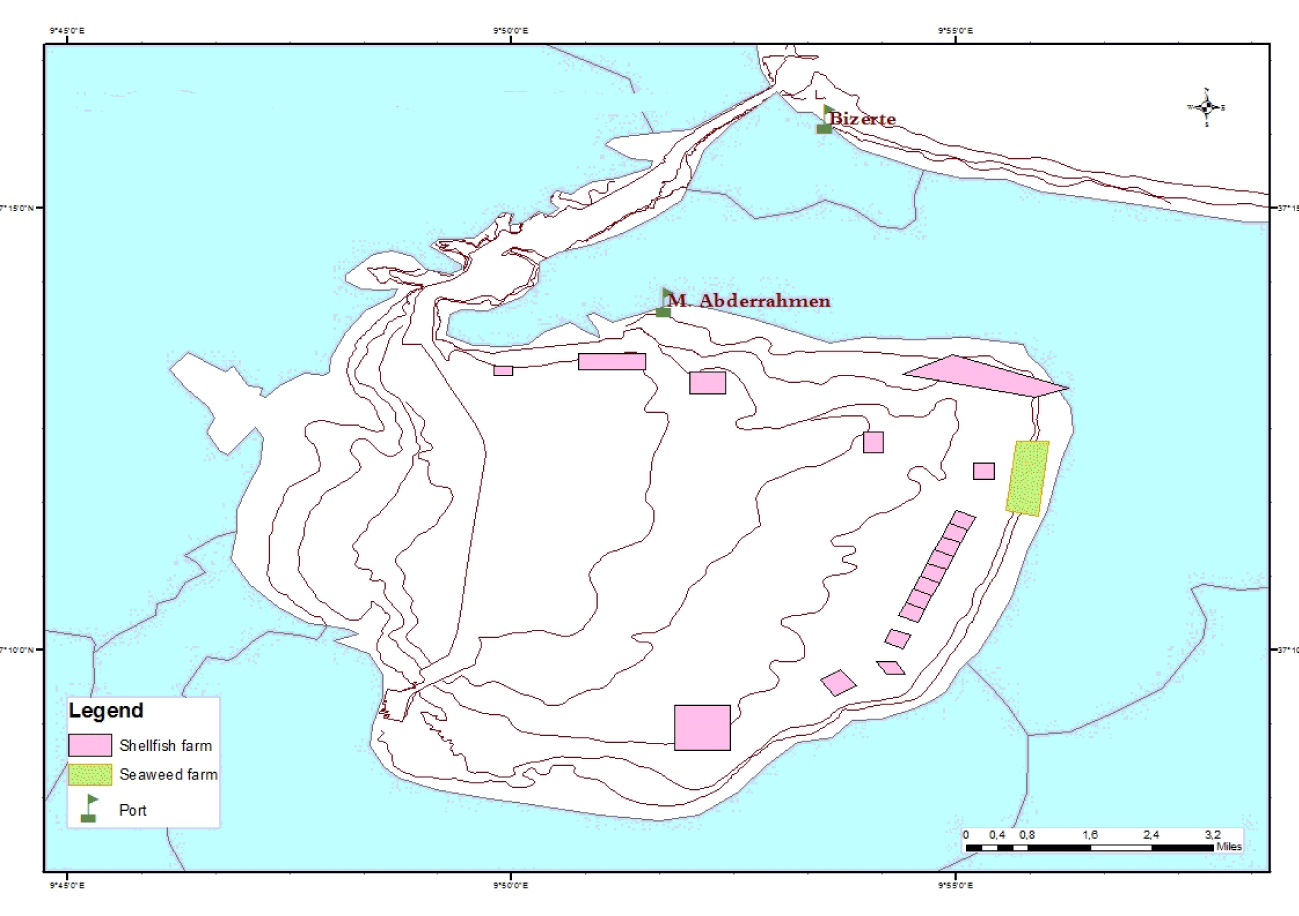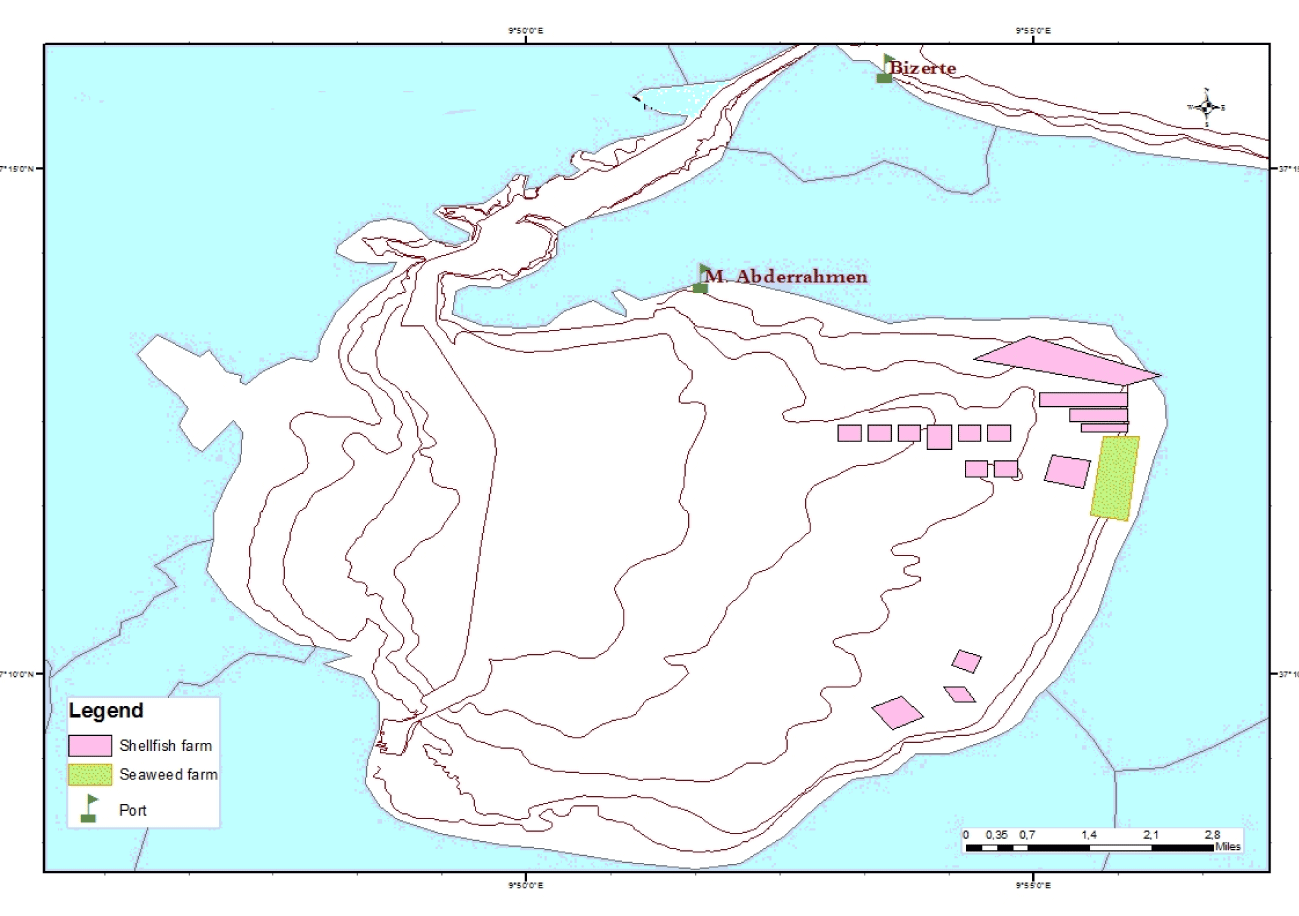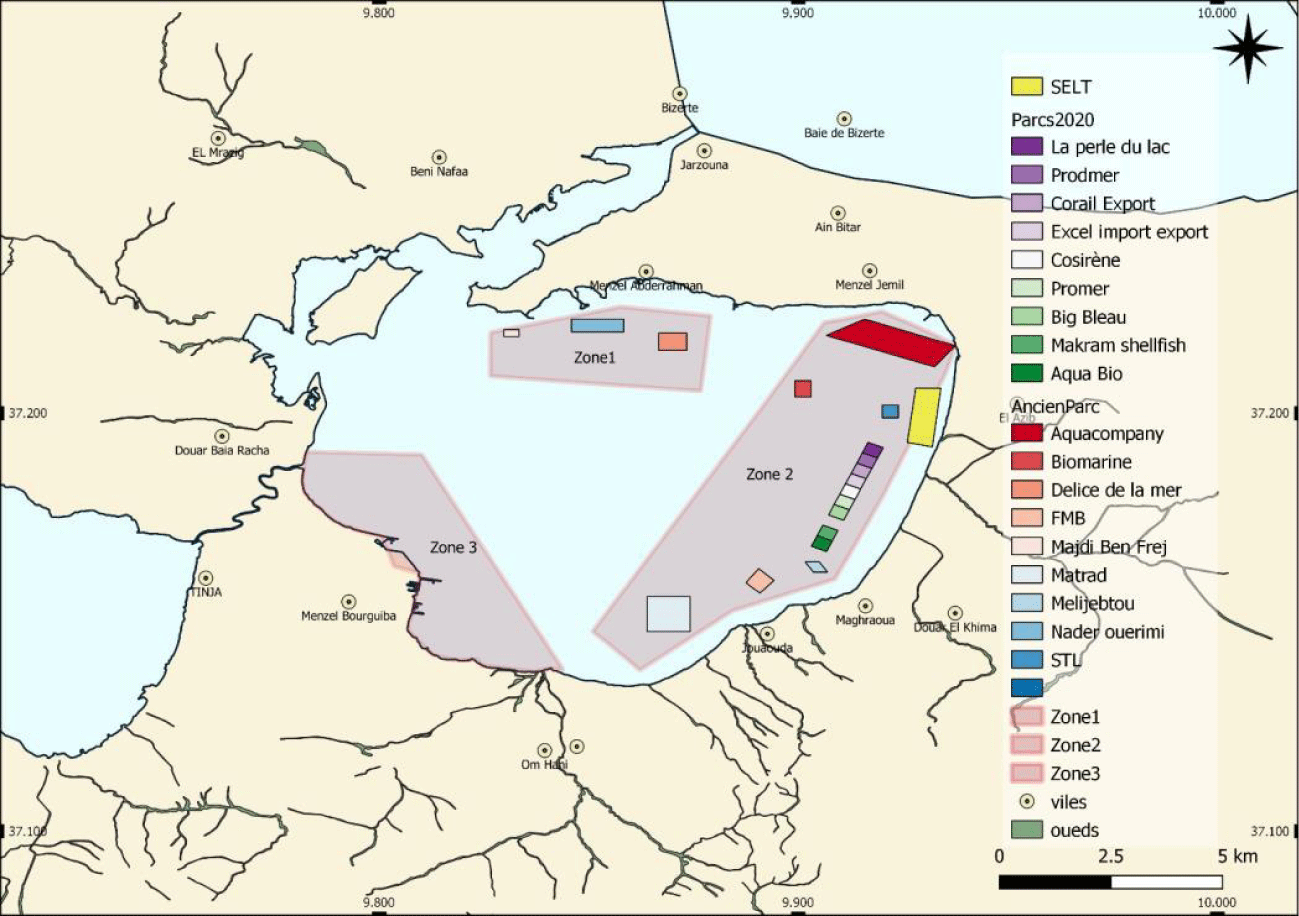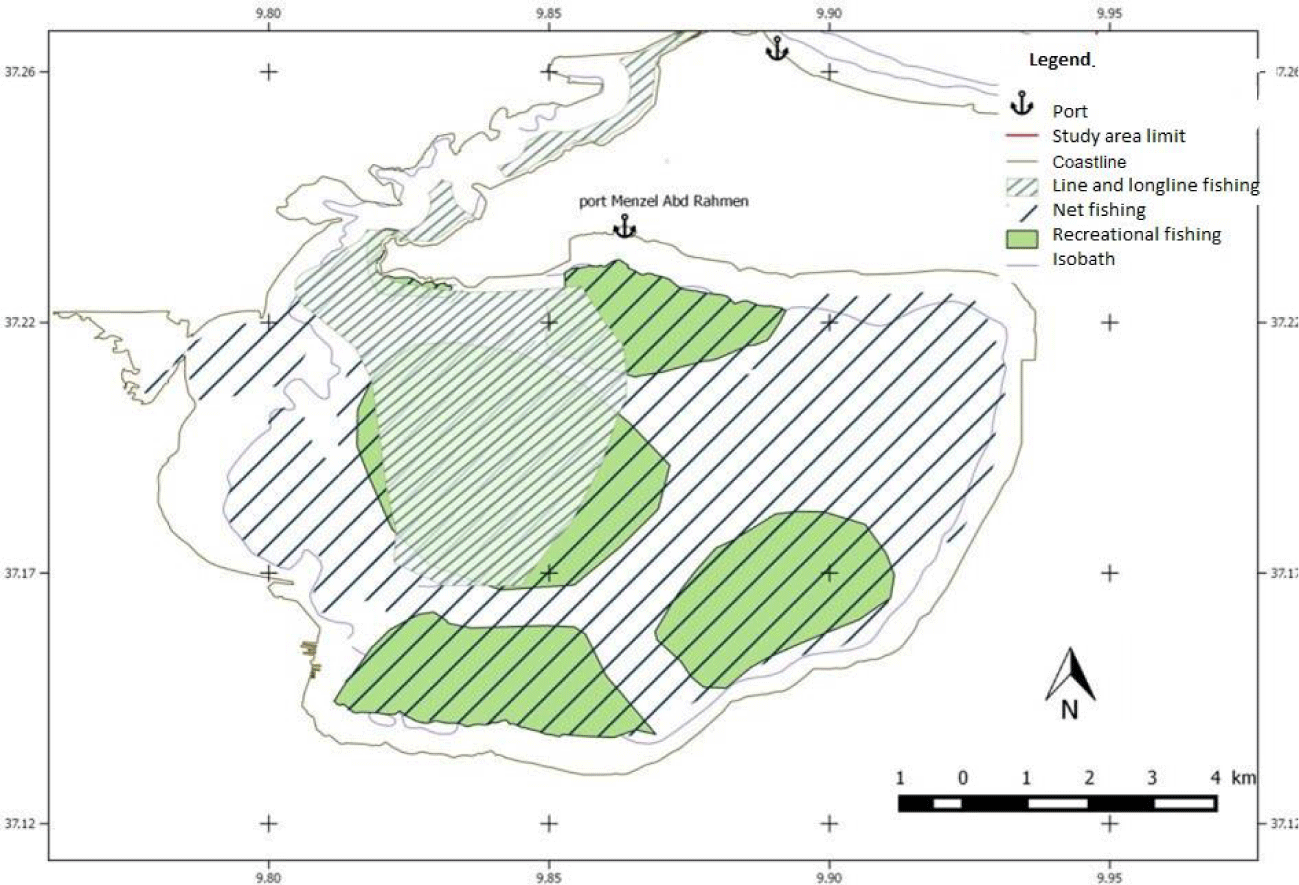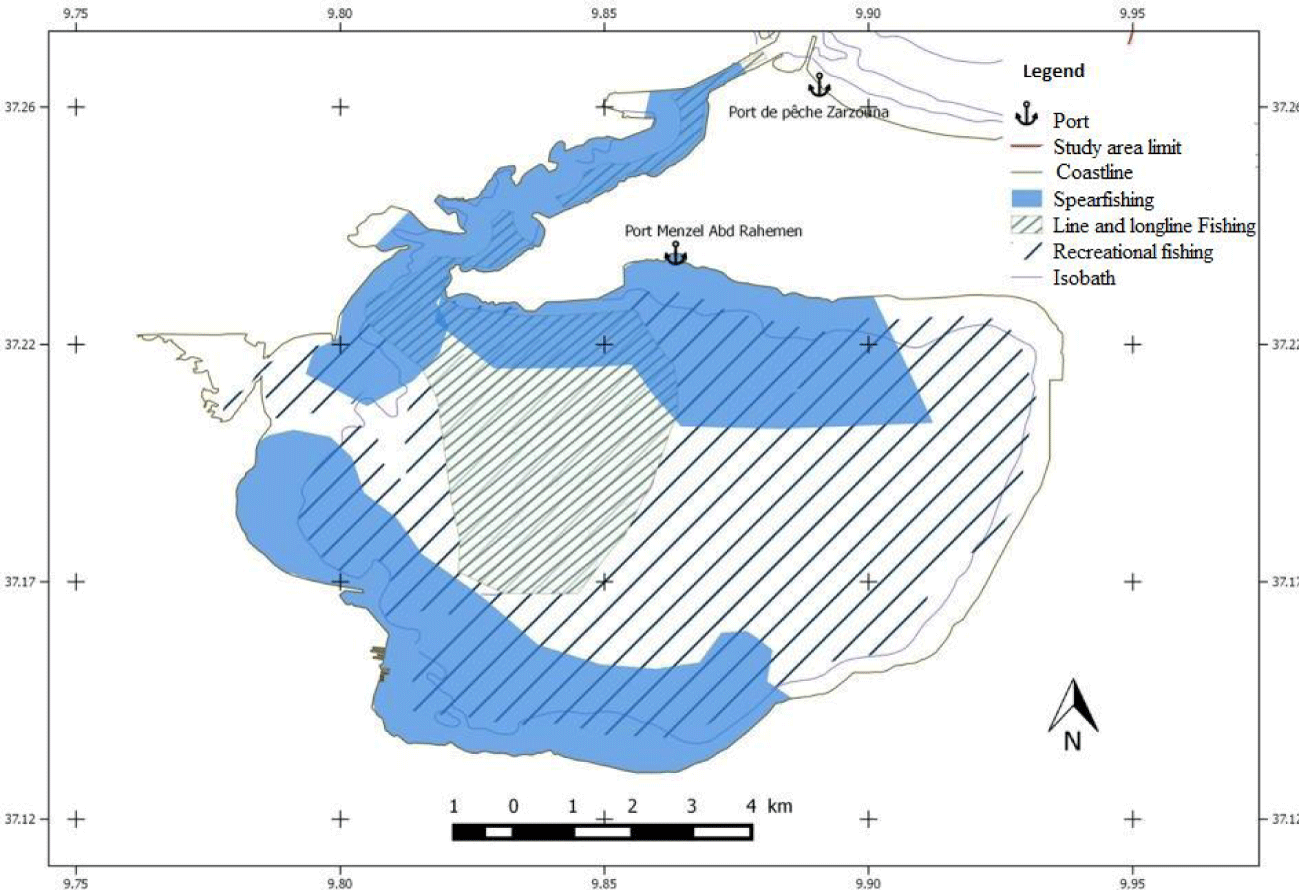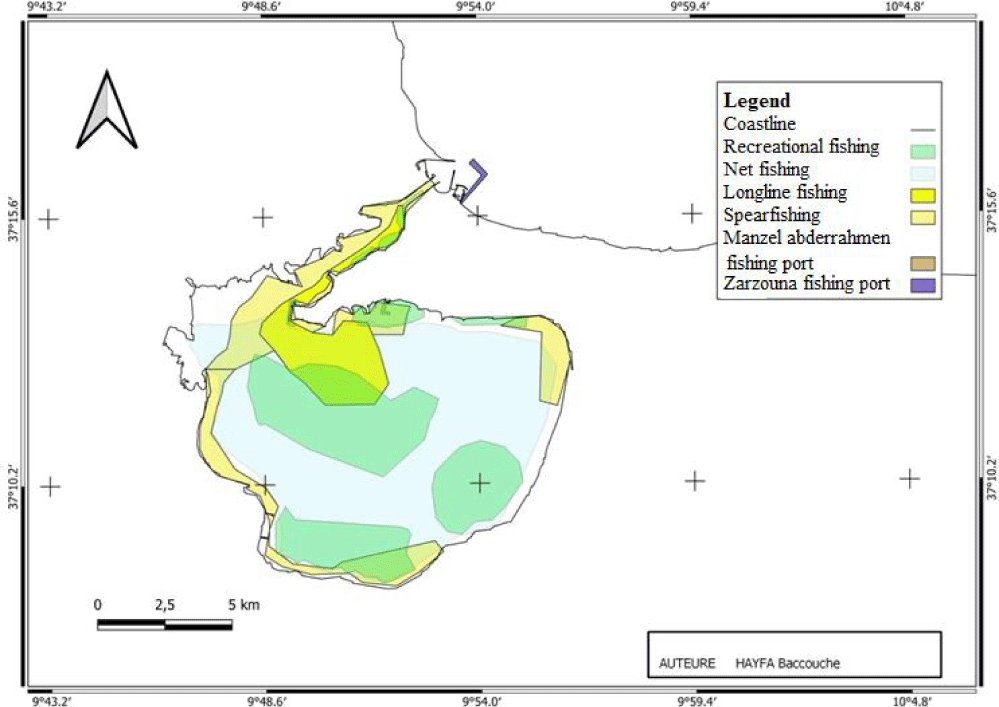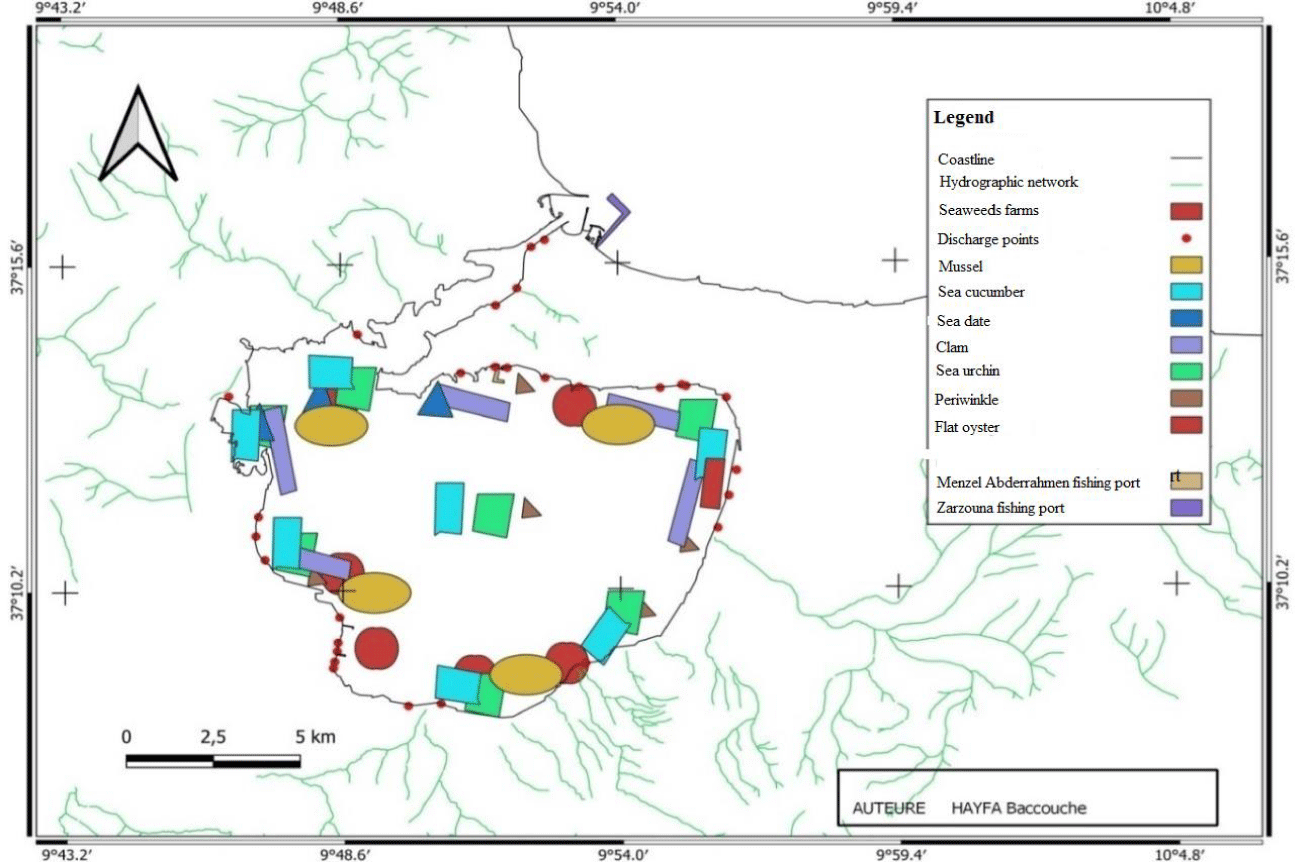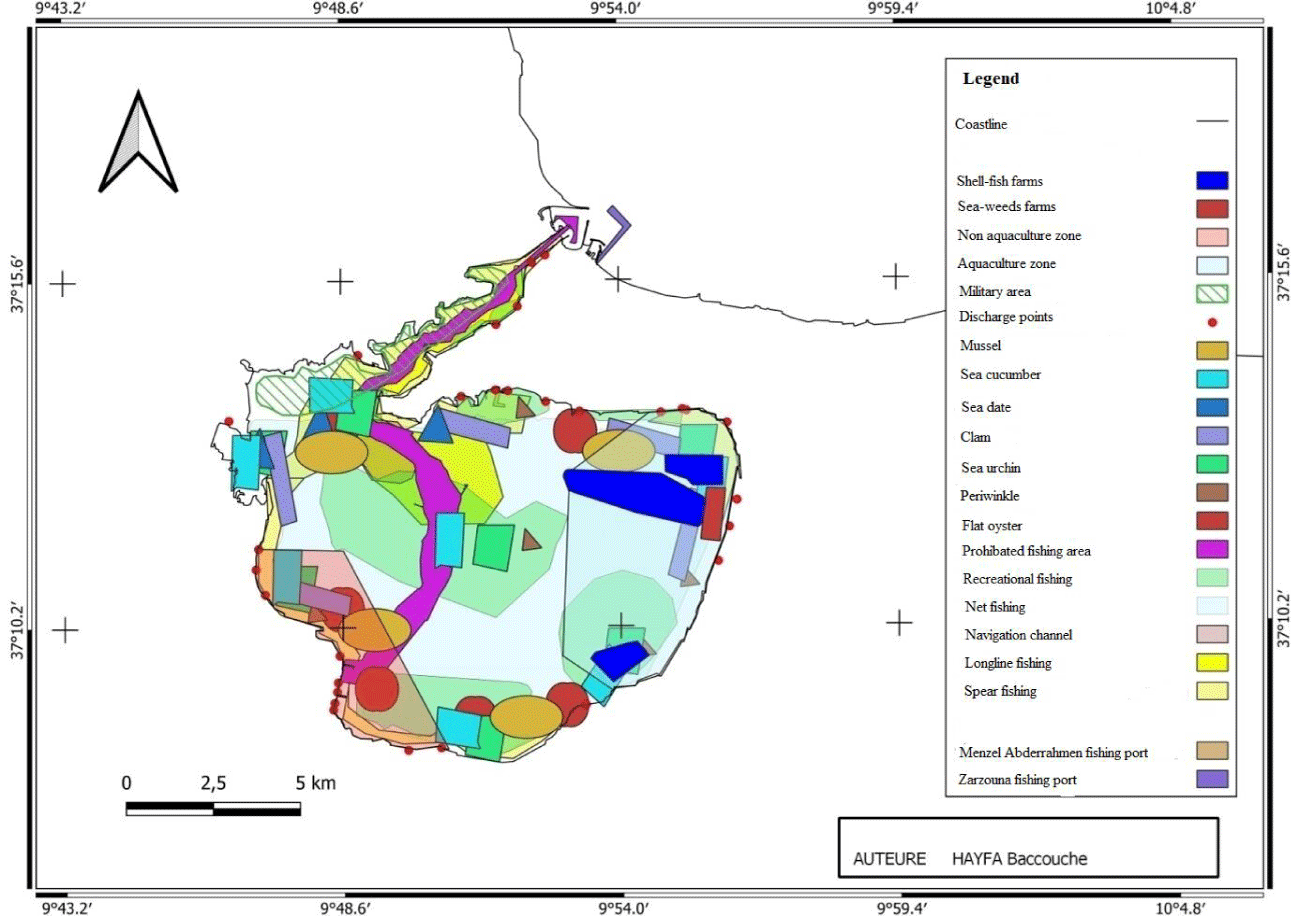Environmental Sciences . 2022 February 05;3(2):149-162. doi: 10.37871/jbres1413.
Review of the Situation of Tunisian Lagoon of Bizerta Using Marine Spatial Planning as a Key to Sustainable Blue Growth
Basma Hamdaoui2, Rym Ennouri1, Manel Fatnassi1, Hajer Zarrouk1, Naoufel Romdhane2, Mohamed Chalghaf3 and Sami Mili1*
2Directorate General of Fisheries and Aquaculture, Tunisia
3Technical Center of Aquaculture, 5. Rue du Sahel Montfleury, 1009 Tunis, Tunisia
- Sustainable blue growth
- Marine spatial planning
- Coastal fisheries
- Allocated zone for aquaculture
- Shell fish farming
- Management
- Bizerta lagoon
- Tunisia
Abstract
Bizerta lagoon is an important socio-economic pole in northern Tunisia. Its shores and maritime space host lots of human activities, such as coastal fishing, shellfish farming, maritime traffic, military activity, recreational fishing and nautical sports. These activities cause severe pollution and they result in many anthropogenic disturbances. Naturally, conflicts of interest between the different operators have always existed. However, recently these disagreements, particularly between coastal fishermen and shellfish farmers have degenerated into an act of vandalism in November 2019. Fishermen destroyed all the bivalve farms facilities and productions. This act is the result of the build-up of several factors, notably the spatial interaction between the two activities and the improper practices of the shellfish farmers, which are according to fishermen “the major source of the lagoon pollution”.
Despite the fact that the Tunisian government has made considerable efforts to solve this issue, mitigate this conflict, and restore shellfish farming activity in the lagoon, this event has had major socio-economical, geo-political, environmental, and technological impacts. Within this framework, the current paper aims to suggest a management plan that should improve the lagoon status and attain the desired sustainable development of all activities. Turning to Marine Spatial Planning (MSP), we propose an Allocated Zone for Aquaculture (AZA), effective governance of the lagoon and fostering of Sustainable Blue Growth (SBG). These proposals are in line with the Tunisian strategies in terms of aquaculture sustainable development, establishment of MSP along the entire Tunisian coastline and the promotion of blue economy. They also meet several sustainable blue development objectives of the United Nations.
Introduction
Bizerta lagoon is located in the north of Tunisia between latitudes 37°8' and 37°14' and longitudes 9°46' and 9° 56' (Figure 1). It covers an area of about 128 km2, with a width of 11 km and a length of 13 km. It communicates in its north-western part with the Mediterranean Sea through a channel of about 6 km length and in its western part with Ichkeul Lake through Oued Tinja of about 5 km length and 3 meters depth (in flood period) [1-3]. The hydrographic network associated with Bizerta lagoon is quite well developed and is the result of various watersheds. In winter, a surplus of fresh water from Ichkeul Lake flows to Bizerta lagoon via Oued Tinja, while during the dry period; this oued allows marine waters to reach Ichkeul Lake through Bizerta lagoon [2]. This lagoon is characterized by an important biodiversity and by a high biological productivity, which makes of it a nursery for several marine species, a place of broodstock maturation for others and a feeding area for many migratory species [2].
Watershed of Bizerta lagoon plays an important socio-economic role and encourages an important demographic concentration. Several maritime activities are carried out in the lagoon, mainly coastal fishing as well as mussels and oysters farming which have been introduced since 1951 [4]. In addition to fishing activities, the lagoon attracts different leisure activities such as recreational fishing and nautical sports. Moreover, it shelters a military zone, a commercial port (Menzel Bourguiba) and a fishing port (Manzel Abderrahmen). Different scientific reports [4-7] inform that the lagoon is subject to many sources of pollution due to anthropogenic activities. It is the receptacle of a well-developed hydrographic network composed of several streams that carry agriculture discharges and wastewater discharge points from the surrounding districts (domestic and industrial) [7]. Other factors, such as climate change and proliferation of invasive species are increasing the complexity of the lagoon's spatial management.
The limited area of the lagoon and the multiplicity of activities conducted there naturally lead to several types of conflict of interest regarding the usage of space between the different stakeholders: in aquaculture, professional fishing and recreational fishing. As a matter of course, this nuisance has negative socio-economic impacts. These competing interests between coastal fishermen and shellfish farmers have generated an act of vandalism in November 2019. Fishermen damaged facilities of existent shellfish farms, causing the loss of 90% of production and the delay of the installation of new projects. Estimates of the damage are between 6 and 8 million Tunisian dinars [8].
The current paper, relates to the preparation of a project proposal on the establishment of Marine Spatial Planning (MSP) and the promotion of sustainable blue growth opportunities in Bizerta lagoon. The aims of this work are to mitigate the conflicts of interest between fishermen and shell fish farmers; to contribute to the development of the socio-economic and environmental aspects; and to promote the social acceptability of the activity of shellfish farming in Bizerta lagoon.
Maritime Spatial Planning (MSP), being built on scientific bases, can overcome the different pressures on the lagoon and contribute to mitigate the various conflicts of interest between the different stakeholders. It will allow to set up a sustainable development strategy for fishing and aquaculture sectors and to define Allocated Zones for Aquaculture (AZA) mainly for shellfish farming and other activities. Through this paper, we tried to find adequate solutions for the spatial conflicts between fishermen, shellfish farmers and other users in Bizerta lagoon, which led to the vandalism act of November 2019.
Presentation of the Fisheries and Aquaculture Activities in Bizerta lagoon
Bizerta lagoon hosts more than 180 small scale fishing boats and it is explored by more than 600 fishermen and 60 aquaculture workers. The average total production of the lagoon for the last 10 years (Figure 2) was about 270 tons: 25% from fishing activities (about 70 tons) and 75% from shellfish farming. However, shellfish activity occupies only 3% of the lagoon area [9]. The Student Test reveals a significant difference between the production of shellfish and fisheries (p = 000001 < 0.05). In addition, One way ANOVA test applied reported a difference for the production variation of shell fish among years with F = 4.8000 and p = 0.001200; same result found for the production of fisheries with a significant variation (F = 6.5000 and p = 0.0090).
It is important to indicate that the production goals fixed by the government have not been achieved due to over-exploitation of resources, IUU fishing, pollution and conflicts of interest between fishermen and shellfish farmers [8]. The main targeted species in the lagoon are the cuttlefish Sepia officinalis, the sea bass Dicentrarchus labrax, different species from Sparidae and Mugilidae families, the eel Anguilla anguilla, the shrimp Penaeus kerathurus and the flat fish Solea senegalensis [9]. The fishery production of the lagoon is often landed in the coastal port of Menzel Abderrahman.
For shellfish aquaculture, two species are farmed in the lagoon. These are the European mussel Mytillus galloprovincialis which reproduces naturally in this area and the oyster Crassostrea gigas, allochthonous specie, which cannot reproduce naturally in the ecosystem. Its production depends on the availability of spat and the importation or occasional production from the shellfish hatchery of the Higher Institute of Fisheries and Aquaculture which is managed by the Technical Center of Aquaculture. The farming method adopted for shellfish aquaculture is suspension culture, on raft systems and longlines with average "declared" production of about 200 tons/year where mussels occupy the first place (about 80% of the total production) [9]. The development of shellfish aquaculture is nowadays one of the scopes of the national strategy to cope with two major issues. These are the depletion of natural stocks of clam Venerupis decussata, where the production has decreased from 1635 tons in 2014 to 44 tons in 2020, and the need to create new jobs [9]. Within the framework of the government’s strategy to promote sustainable aquaculture in Tunisia and increase aquaculture production, a regional advisory committee has been set up, since 2015, to study new applications for the installation of a new project involving all stakeholders (administration, professional, scientific research, civil society...). As a result, new operating authorizations have been issued, since 2017, for 8 shellfish projects with a production capacity of 1200 tons/year as well as a farm for seaweed aquaculture (450 tons’/year production capacity) (Figure 3).
Lovatelli [10] reported that the investigation of the existing legal framework related to the procedures for site selection and management in the Mediterranean States has pointed out a lack of a specific legal framework for aquaculture (limiting the integration of this sector with other coastal activities). Quite often, the unavailability of such a framework engenders conflicts between stakeholders [11,12] causing human welfare risks [13].
In November 2019, a vandalism act took place due to several reasons: the interaction on a space for fishing activities and aquaculture ones; fishermen’s belief that the aquaculture activity is the main source of pollution of the lagoon and the cause of the decrease in the production of coastal fisheries; the improper practices of shellfish farmers (disposal of waste at the bottom of the lagoon); the exceeding of the limits of concessions issued to the farms which are already installed; and the poor representation of the fishermen in the regional advisory committee. This act has caused a big damage to the activity: 14 out of the whole 15 installed projects were destroyed where only 4 out of 9 productive projects could save only 10% of their productions and commercialize them between November 20 and December 31, 2019 [8]. Eventually, a ministerial committee was formed by representatives of different stakeholders in order to assess the damage and suggest a roadmap (management plan) for the sustainable development of the fisheries sector and aquaculture in Bizerta lagoon. The damage was estimated between 6 and 8 million Tunisian dinars. The interruption of shellfish production has negatively affected all the parts of the shellfish value chain, especially the activity of the purification centers and the bivalve export units.
Regarding this situation, the Tunisian government, quickly reached a partial resolution of the conflict. This was achieved through the relocation of most of the farms adopting a participatory approach based on direct consultation with the actors, field surveys and meetings at the regional and national levels. These actions led to the creation of an allocated area for shellfish farming where the projects were reinstalled (Figure 4). This decision was not based on scientific data but on concertation between representatives of fishermen and shellfish aquaculture farmers.
Urbanization Impact in Bizerta Lagoon
Bizerta Lagoon is located in a highly populated area and is subjected to environmental pollution [14]. The watersheds flowing into the lagoon are affected by several anthropogenic pressures resulting from industrial, urbanization and agricultural activities (metallurgical industry, cement works, tire factory pollution, etc.) [14,15].
The industrial pollution is resulting from hy-drocarbons and heavy metals [12,16-19] which come from about 400 industrial units which were created as early as the 1950s on the shores of Bizerta lagoon. The contents of trace elements in the sediments show an accumulation of Mn, Zn, Pb, Ba, Cr, Cu and Ni [20,21]. According to Béjaoui, et al. [4], the most traced elements building up in the sediments of all the area of the lagoon are Pb (35 to 100 mg.kg-1) and Zn (210 to 450 mg.kg-1). The urban pollution consists of organic and bacterial components and it results, on the one hand, from the discharges of more than 10 million m3 of the main districts located along the shores of the lagoon and on the other hand, from untreated wastewater [22,23]. The sediments constitute the potential reservoir for different bacterial populations [24] and the shores are severely contaminated. Souissi, et al. [25] and Saidi, et al. [21] showed that different species of faecal bacteria are proliferating and acquiring resistance to several antibiotics. The persistence of these bacterial populations, especially during the summer season, poses a significant health risk, particularly for shellfish farming [4,26,27]. Recently, new risks were identified in the lagoon in association with contaminating microplastics which tend to absorb chemical pollutants [28-30]. The agricultural pollution is the result of the intensive land cultivation in the proximity of the lagoon, which often requires fertilizers and excessive use of pesticide treatments. These compounds are carried away during the irrigation process and end up flowing into the lagoon.
The nomenclature and taxonomy of direct human-induced disturbances in Bizerta lagoon is reported in tables 1-4 according to the International Union for Conservation of Nature and Conservation Measures Partnership (IUCN-CMP).
| Table 1: Taxonomic nomenclature of direct human threats in Bizerta lagoon (taxonomic level 1) and genus (level 2). | |
| Direct threat (threat family: level 1 and genus: level 2) | Types |
| 1. Residential and commercial development | |
| 1.1 Housing and urban areas | Urban agglomerations |
| 1.2 Commercial and industrial areas | Manufacturing plants, military bases, shipyards |
| 2. Agriculture and aquaculture | |
| 2.1 Marine and freshwater aquaculture | Shellfish farms, seeded shellfish beds |
| 3. Transportation and service corridors | |
| 1.1 Shipping lanes | Naval base, navigation canal for commercial ships and yachting clubs |
| 4. Human Intrusions and Disturbance | |
| 4.1 Recreational activities | Leisure fishing activities, nautical sports |
| 4.2 Work and other activities | Military uses, commercial port, fishing port, maritime activities, anthropogenic activities, shelfish farmers, vandalism |
| 5. Invasive and other problematic species and genes | |
| 5.1 Invasive non-native/alien species | Viral, bacterial and protozoan pathogens, invasive species (crabs: Portunus segnis and Callinectes sapidus; bivalve mollusc: Pinctada imbricata radiate; Jellyfish: Rhopilemano madica; seaweed: Caulerpa taxifolia; phanerogam: Halophila stipulacea) |
| 6. Pollution | |
| 6.1 Household sewage and urban waste water | Effluent discharge from urban zones, untreated sewage |
| 6.2 Industrial and Military Effluents | Toxic chemicals from industrial units (shipping building, metallurgy, tyres industry, fabric industry, electronic equipment, cement, etc.), illegal dumping of chemicals, leakage from fuel tanks of boats, heavy metals and trace elements in river sediments and water column, military arsenal |
| 6.3 Agricultural and forestry effluents | Fertilizers and pesticides from surround agriculture lands (intensive agricultural activities) |
| 6.4 Garbage and solid waste | Urban zone waste, flotsam and jetsam from recreational and fishing boats, used nets and waste of shellfish farms |
| 6.5 Air-borne pollutants | Atmospheric pollutants from factories |
| Table 2: Zoning for shellfish aquaculture in Bizerta lagoon Based on data collected on the circulation of water and the distribution of heavy metals and bacteria [5]. | |||
| Zone | Circulation of water | Level of metallic and organic pollution | Aquaculture Suitability |
| 1 | High | Low | Less suitable for aquaculture |
| 2 | Low | Low | The most suitable for aquaculture |
| 3 | High | High | Unsuitable for aquaculture |
| Table 3: Classification of human activities in Bizerta Lagoon [33]. | |||
| Usage | Activities | Sub-activities 2 | Sub-activities 3 |
| Exploitation of living resources | Professional fishing | Dragging arts | Hook and line fishing |
| Dormant arts | Longline fishing ; Netting | ||
| Aquaculture | Shell fish farming | Mussel culture ; Oyster farming | |
| Seaweed farming | Gracilaria | ||
| Maritime navigation | Trade navigation | ||
| Fishing boat navigation | |||
| Military defense | Military activity | ||
| Leisure and sports | Water activity | Water sport | Kayak ; Sailboarding ; Diving |
| Recreational fishing | Pleasure fishing on board; Beach fishing; Spearfishing | ||
| Table 4: SWOT Analysis assessing the present situation of Bizerta lagoon. | ||||
| Strengths | Weaknesses | Opportunities | Threats | |
| Natural / Environmental |
Rich ecosystem High biological productivity Natural stocks of many species Nurseries for many species Area of maturation of brood stock Feeding area for migratory species |
Pollution Climate change Proliferation of Alien species |
Depollution: Achievement of Ecopact program of depollution of Bizerta lagoon Exploitation of invasive species - |
Persistence of pollution Algea bloom (in summer) Proliferation of bacteria Ecosystem imbalance |
| Social | Involvement of civil society in different projects will have a positive impact on the success of its activities. | Conflict of interest between different users Lack of social acceptability of aquaculture |
Mitigation of conflict of interest between different users Promotion of social acceptability of aquaculture |
Reluctance of the beneficiaries of this project to join. Non-acceptance of the introduction of new potentials of fisheries and aquaculture by all actors |
| Strengths | Weaknesses | Opportunities | Threats | |
| Economic | Economic development of many activities and sectors Important employability Important vessel of fishing boats Many shellfish farms are installed and productive New project of seaweed farming |
Investment is limited by many factors (pollution, spatial interaction, conflict of interest, administrative process) | Potential of development of SBG opportunities of employability in many sectors and activities Creation of new fisheries (natural stocks and invasive species) Implementation of new farming activities Creation of new jobs (aquaculture farm waste recovery and exploitation of invasive species) |
Economic crisis and decrease of investment in Tunisia Decline in the fishery and aquaculture production Drop of the number of aquaculture farms Global pandemic (like covid 2019) |
| Scientific / Technological | Many studies conducted in many fields about Bizerta Lagoon Shellfish hatchery of Bizerta of CTA |
Lack of data relating to the eco-biology and the state of exploitation of stocks of many species | Introduction of new technologies (fisheries and fish farming) Conduction of new studies in new fields (MSP, Modelization, Depollution, ecotourism) |
Reluctance of the fishermen and shellfish farmers to introduce new technologies |
| Strengths | Weaknesses | Opportunities | Threats | |
| Governance | Intervention of many stakeholders Assignment of regional advisory committee since 2015, to study new applications for installation of new project with the involvement of all stakeholders Menzel Abderrahmen fishing port Official control Well-developed regulatory and legislative framework |
Lack of fishing port services (cold storage and wholesale market) Lack of professional organizations Lack of zoosanitary classification. Limited official control |
Creation of professional organizations Extension of Menzel Abderrahmen fishing port Strengthening of official control Establishment of guide to good shellfish farming practices Increasing awareness of farmers of importance of good practices zoosanitary classification |
Non respect of regulation by all actors Non respect of concessions areas by shellfish farmers Reluctance of the fishermen and shellfish farmers to join PO |
| Management | Overexploitation IUU fishing (professional and recreational fishing) Conflicts of interest between actors Spatial interaction between activities |
Marine Spatial Planning Establishment of AZA Proposition of allocated area for recreational fisheries Achievement of GFCM project Achievement of FAO project Proposition of our new project |
Reluctance of actors to Marine Spatial Planning Reluctance of fishermen to AZA Continuation of overexploitation and IUU fishing |
|
The program of Integrated Depollution of Bizerta Lagoon "Ecopact" financed by the European Investment Bank (EIB) in the framework of the "Mediterranean Hotspots Investment Program (MeHSIP)" is the first investment program labelled in the framework of the Euro-Mediterranean Initiative Horizon 2020. The overall goal of this program is to improve and even restore the quality of the waters and ecosystems of Bizerta Lagoon in order to promote a sustainable socio-economic development and improve the quality of the citizens’ life. The total cost of this program is 90 million euros and it includes 30 investment and support projects. One of the selected projects in the coastal area of Menzel Abderrahmane is the rehabilitation and extension of the fishing port (This study has taken into account the needs of the shellfish sector) [31].
On the request of the General Directorate of Veterinary Services (DGSV) in 2017, the National Institute of Marine Sciences and Technologies (INSTM) conducted a study to identify a zoning for shellfish aquaculture in Bizerta lagoon and to propose appropriate stations to collect samples for assessment of the sanitary status of shellfish. Based on data and information collected on the circulation of water and the distribution of heavy metals and bacteria, this study has allowed splitting Bizerta lagoon into three zones (Figures 5,6). Each one has relatively homogeneous physical and environmental characteristics [5].
Different Users in Bizerta Lagoon
In addition to the fishing and aquaculture activities, Bizerta lagoon hosts several other activities, such as maritime traffic, military activity, port activity, recreational fishing, and water sports. It contains a military zone, a coastal fishing port, a navigation channel for commercial ships, and yachting clubs.
In order to establish Marine Spatial Planning, it is important to classify the associated activities in the lagoon. To do this, we opted for Tixerant typology [32] which allows organization into several levels according to the mode of usage. Thus, we split the activities into activities and sub-activities [33].
Introduction of MSP in Bizerta Lagoon
Two research studies have been conducted in order to introduce MSP in the lagoon of Bizerta: Gharsalli [33] and Baccouche [34]. The collection of information during these studies was based on field surveys with all stakeholders. The achieved results based on questionnaires (201 for the first study and 95 for the second study) helped to identify and map the different activities in the lagoon using an appropriate GIS tool. The layering of these maps allowed to find the "spatial" interactions between users and to highlight possible conflicts between actors.
The first study which was conducted in 2016, before the vandalism act, showed several conflicting relationships between the actors operating in the lagoon. The major spatial conflict revealed by this study was between professional and recreational fishing (Figure 7).
The fishermen are very concerned about the recreational fishing activity; they complain about the use of illegal nets and illegal sale of fishing products to the public, and therefore feel their income is being endangered [33]. According to this study, a spatial conflict also exists between professional fishing and shellfish farming (Figure 8).
Indeed, most fishermen consider shellfish farming as a source of disturbance to the fishing activity because of the area occupied and shellfish farmers' wrong practices contributing to the lagoon's pollution [33]. The shellfish farmers, on the other hand, confirmed that they kept good relationship with the fishermen and that they allowed them to fish in the surrounding area of the farms (forbidden to fishing). They also said that the fishing activity has never presented a problem for shellfish farming, but their major concerns are pollution and theft of their materials and equipment [33]. This study also showed the existence of a spatial conflict between professional fishing and spearfishing (Figure 9). In fact, fishermen complained about using prohibited fishing gear and damaging their nets [33].
The second study recently conducted in 2021 (after the act of vandalism) has revealed that the conflicting relations are still existent between the different actors in the lagoon. In fact, according to this study, fishermen’s distress is mainly caused by the impact of the invasive non-indigenous species on the lagoon's fisheries, as well as the recreational fishing, followed by pollution [34]. Thanks to the new spatial distribution of shellfish farms, shellfish farming no longer constitutes a major problem for fishermen. However, fishermen still complain about the wrong practices of shellfish farmers, especially the disposal of used nets and waste which settle on the ground and cause pollution. The shellfish farmers also stated that their main concern is the theft and pollution of the lagoon [34]. This study revealed that the conflict between professional and recreational fishing still persists (Figure 10).
Indeed, fishermen find the improper practices of the recreational fishermen very annoying and devastating because of their disrespect of the regulations and the usage of illegal fishing gear and methods. It also shows the persisting spatial conflict between underwater hunting (illegal) and professional fishing. This study also demonstrated a spatial interaction between the discharge points and the natural stocks of bivalves and echinoderms (Figure 11).
Baccouch [34] indicated the occurrence of a new issue that affects the fishermen of Bizerta lagoon. Surveys revealed fishermen's rejection of the fishing of invasive species such as the crabs Portunus segnis and Callinectes sapidus as well as the bivalve mollusc Pinctada imbricata radiata. Besides, according to local fishermen, Jellyfish Rhopilemano madica, the seaweed Caulerpa taxifolia and the phanerogam Halophila stipulacea are causing a great waste of time and money (torn and clogged nets) [34]. Another issue which was raised by the fishermen is the shortage of port services in Menzel Abderrahmen. The lack of refrigeration equipment, for instance, forces them to sell their products to intermediaries who control the selling prices. In addition, they indicated that the quays and landing stages are not suitable to the number of boats that operate in the port [34].
The superposition of all the geo-entities is represented by the interaction map (Figure 12) of all activities. This map highlights the complexity of the management of Bizerta lagoon's maritime space.
Impacts of the Act of Vandalism (November 2019)
The act of vandalism of November 2019 has generated impacts of different sorts: socio-economical, geopolitical, technological and environmental.
At the socio-economic level, the shellfish production has sharply dropped from 169 tons in 2019 to 62 tons in 2020 as a result of the aforementioned vandalism act [8,9]. This decline has greatly affected all operators of the value chain of this product. It has undoubtedly affected the activity of export units. The activity of the bivalve purification centers was almost stopped in 2020. Eventually, many jobs were lost and the employability of the local population was affected, which in turn, triggered many social problems, such as unemployment, poverty, immigration, theft, crime, etc. At the geo-political level, the production objectives set by the Tunisian government in terms of aquaculture development, especially shellfish farming, have not been reached. The five-year strategy 2015-2020 for aquaculture development has aimed to reach 300 tons of shellfish production in 2020. This goal has not been met because of several factors, among which are pollution and spatial conflicts between different actors; the vandalism act has worsened this critical situation. The governance of the fisheries and aquaculture sectors in Bizerta lagoon has become more complex and weaker after this act. Similarly, a delay has been recorded in the installation of new projects and the issuance of new authorizations in 2017 (new projects or regularization of the old projects). At the technological level, the inhibition of investment and the delay in the installation of new projects, has sequentially postponed the introduction of new farming technologies and new fishing techniques, particularly in terms of exploitation of new fisheries (invasive species). At the environmental level, the destroyed infrastructure of aquaculture farms which have fallen into the lagoon have undoubtedly (if not removed) negative effects on the marine environment and the stability of the ecosystem. For this reason, the Tunisian government has ensured that the farmers recover quickly their infrastructure which drowned in the lagoon.
Solutions and Mitigation
To meet the development goals of sustainable blue growth in Bizerta lagoon, we are proposing a management plan for the lagoon based mainly on Marine Spatial Planning.
The first work package is a set of surveys with fishermen and shell fish farmers. Surveys will be carried out to identify different fishing areas and potential new fisheries. Then we will classify them into overfished areas (requiring optimization or more efficient exploitation), efficiently fished areas and underfished areas (with potentials of development, new activities and new income sources). The surveys of the shellfish farmers will allow identifying the suitable areas for aquaculture projects and the new opportunities for aquaculture farming (seaweeds, echinoderms, bivalves ....). The investigations will also address the discharge problem of the shellfish farming activity, the identification of their types (empty shells, plastic ...), the estimation of their quantities and the potential of their recycling and recovery. In addition, the surveys will be a tool to find out interactions and conflicts between different stakeholders in the lagoon.
The second work package will include an inventory for the fisheries and the mapping of their zones based on the scientific data available (stock assessment and fishing effort) and on the results of the surveys carried out among the fishermen and fish farmers. This mapping can also identify the availability of natural stocks of some species that can be a potential for new fisheries development, and so can the invasive species [35].
The third work package will focus on proposing Allocated Zone for Aquaculture (AZA) for shellfish farming activities, as well as AZAs for other potential species for farming (e.g., seaweeds) based on available scientific data (measurement of carrying capacity) and the results of surveys [36]. The creation of the AZA will solve the problem of conflict of interest regarding the use of space between fishermen and shellfish farmers, and this will contribute to promote the social acceptability of aquaculture by the different communities that cohabit the lagoon and its shores. The creation of the AZA will also improve the governance of this sector and facilitate official administrative and sanitary control. Bringing the different farms together will allow to reduce the restricted fishing areas (500 m around the farms) and to facilitate the collection of the different farms’ discharges (shell waste and plastics).
The fourth work package aims to promote the social acceptability of aquaculture in the different stakeholders that coexist in the lagoon and along its shores (fishermen, local citizens, civil society, etc.). It will be carried out through an information day or a seminar to raise awareness about the positive effects of bivalve and seaweeds farming on the economy as well as the environmental (filtration and improvement of water quality).
The fifth work package will focus on the enhancement of the governance of the lagoon by facilitating the setup of a new local professional organization. It will involve both fishermen and shell fish farmers and will be in charge of the management of the lagoon's resources and fisheries. This synergy can help unify visions and opinions and attenuate conflicts. It can also be the source of proposals for the creation or amendment of laws with regards to the lagoon, for example the reduction of the zones restricted to fishing around aquaculture farms (currently 500 ml).
The sixth work package will propose new professions (1) in relation with recycling and recovery of aquaculture farm’s wastes and (2) the fishing, marketing and processing of invasive species, such as the blue crab [37]. The introduction of new jobs promotes both the employability and the attachment of the local population of the surrounding villages to their place. It also allows to involve rural women in new activities and to promote their integration in the economic circuit.
In order to support the strategies of the Tunisian government with regards to the aquaculture sector development and the promotion of blue economy in Tunisia, this paper will facilitate joint reflection on the MSP of all the maritime spaces strategy. Moreover, this work will open new horizons of scientific research. MSP in Bizerta lagoon will identify several research axes in relation to stock assessment and fishing effort of the different natural stocks, the exploitation of new fisheries and the introduction of new farming species. The identification of the lagoon's carrying capacity and the proposal of AZA can inspire other scientific studies in potential sites for aquaculture in Tunisia.
Cross-Cutting Sustainable Aspects
The various actions programmed at the level of our study meet at least four Sustainable Development Goals (SDGs) that have been set by the United Nations for sustainable blue development and which were mentioned in the Sustainable Development Report 2020 [38]. Indeed, this work well supports the implementation of sustainable development according to objective 8 “decent work and economic growth: Promote sustained, inclusive and sustainable economic growth, full and productive employment and decent work for all” and objective 14 “Life below water: Conserve and sustainably use the oceans, seas and marine resources for sustainable development”. In addition, this paper meets the first objective of sustainable development with regards to poverty; “No poverty: End poverty in all its forms everywhere” and the second objective “Zero hunger: End hunger, achieve food security and improved nutrition and promote sustainable agriculture”. Based on these objectives, our work will involve the three pillars of sustainable development, namely the environment, the society and the economy.”
Regarding socio-economic aspects, our paper will contribute to turning the conflict between the fishermen and the shellfish farmers into opportunities through the creation of new potentials and activities of fisheries and aquaculture in Bizerta lagoon. This work will mostly affect fishermen, shellfish farmers, unemployed young people and women. The improvement of the socio-economic environment in the lagoon through management of space, the enhancement of employability chances for the vulnerable local population will (1) promote investment in the lagoon, (2) contribute to increase the shellfish farming production and exportation and, (3) improve the income of both fishermen and shellfish farmers. Besides, the social acceptability of aquaculture especially shellfish farming will be improved and can be further enhanced by the creation of a new professional organization. This organization will bring fishermen and shellfish farmers together and will present an opportunity to manage the available space in the lagoon based on the participatory approach.
The creation of new potentials related to the recycling and recovery of shellfish farm waste will increase the opportunity for the creation of new professions and the improvement of employability as well as the development of the circular economy and the blue economy in the lagoon.
Regarding the environment, our project will contribute to the preservation of biodiversity by identifying the natural stocks existing in the lagoon and proposing strategies for their preservation. The introduction of new aquatic activities such as the farming of seaweeds and echinoderms can contribute to the improvement of the water quality of the lagoon.
Swot Analysis: Bizerta Lagoon Current Management Status
In this part, we will assess the present situation of Bizerta lagoon using SWOT Analysis.
Conclusion
The main objective of the paper is to contribute to the sustainable management of Bizerta lagoon and to mitigate conflicts between fishermen and shellfish farmers. This work will have a vital socio-economic impact by improving incomes of fishermen and shellfish farmers, promoting employability and enhancing the acceptability of aquaculture projects. It consists in proposing a management plan for Bizerta lagoon based on Marine Spatial Planning. It will serve for decision makers in the fisheries and aquaculture sector in Tunisia, to undertake the required actions for the sustainable management of the lagoon at the organizational, regulatory and scientific levels. The actions will be related to the proposal of AZA, the creation of a professional organization, the strengthening of official control of concessions delivered to farms and the application of the best practices by shellfish farmers. This project is in line with the strategies of the Tunisian government in terms of development of the aquaculture sector, the promotion of the blue economy and the implementation of MSP in the entire Tunisian coastline.
This paper will surely have scientific impacts, since MSP will highlight several research and development potentials related to the exploitation of new fisheries and the introduction of new farming activities. MSP can also highlight suitable areas intended for farming of seaweeds that will serve for both the creation of new projects and professions and the improvement of the lagoon's environmental situation.
The Tunisian government's efforts to mitigate the conflicts between fishermen and farmers in Bizerta lagoon which culminated in November 2019 and the relative improvement of the management situation of the lagoon have attracted many international donors. The aim was to deeply investigate the problem and set up projects to support the efforts of the Tunisian government. Two projects have been selected: the GFCM has secured funds for the evaluation of the carrying capacity of the lagoon in order to propose AZA and the FAO has approved a TCP entitled "Elaboration of a management plan for Bizerta lagoon in Tunisia for a territorial socio-economic development". The Tunisian government has scheduled also the expansion of Menzel Abderrahmen Port considering the aquaculture activity. It will provide facilities for aquaculture projects and various port services needed. The extension of the fishing port and the improvement of its services will contribute to the amelioration of the situation of fishermen and shellfish farmers. The construction of cold storage and wholesale market will facilitate the distribution and commercialization of products, improve their traceability and promote their export.
Strengthening of the lagoon's governance is a very important challenge. It is therefore important for all stakeholders to obey the regulation: shellfish farmers must comply with the limits of the concessions and apply the best farming practices; professional fishermen have to use regulated gear and act in accordance with regulations regarding the fishing zones; recreational fishermen must adhere to the use of boats, used gear and sales; nautical sports must use the allowed type of gear and respect of the quota (regulation).
Bizerta lagoon possesses important natural and socio-economic potentials and it is able to attract investors and bring new projects. These potentials can initiate opportunities to generate new jobs and promote Sustainable Blue Growth.
References
- Béjaoui B, Harzallah A, Moussa M, Chapelle A, Solidoro C. Analysis of hydrobiological pattern in the Bizerta lagoon (Tunisia). Estuar Coast Shelf Sci. 2008;80:121-129. doi : 10.1016/j.ecss.2008.07.011.
- Béjaoui B. Development of a Three-Dimensional Coupled Dynamic-Ecology Model: Application to the Bizerta Lagoon. Specialty thesis report in hydraulic engineering. ENIT, Department of Hydraulics. 2009;210.
- Béjaoui B, Ferjani D, Zaaboub N, Chapelle A, Moussa M. Caractérisation hydrobiologique saisonnière de la lagune de Bizerta (Tunisie). Revue des Sciences de l’Eau. 2010;23(3):215-232. doi:10.7202/044686ar.
- Béjaoui B, Elamri D, Bouali H, Salem H. Zoning of the Bizerte Lagoon for Shellfish farming and Identification of Sampling Stations for Sanitary Control. National Institute of Science and Technology of the Sea. 2021;41.
- Bejaoui B, Zaaboub N, Elbour M, Elamri D, Hili H, Chalghaf M. Zoning of the Bizerta lagoon. National Institute of Science and Technology of the Sea. 2017;31.
- Derouiche S. Industrial waste management in the Bizerta lagoon. Scientific Report. Faculty of Sciences of Bizerte. 2019;7.
- Horizon. Integral depollution of Lake Bizerta, Mediterranean Hot Spot Investment Program, Feasibility study, Ministry of Equipment, Regional Planning and Sustainable Development. 2020-2013;228.
- DGPA. Strategic study of fisheries and aquaculture on the horizon. 2019;21.
- DGPA. Report on Fisheries and Aquaculture Statistics in Tunisia. 2020;143.
- Lovatelli A. Webinar: Regional review on status and trends in aquaculture development in the near East and North Africa-2020. FAO Aquaculture Newsletter. 2021;(63):21-22.
- Lillebø AI. Coastal Lagoons in Europe: Integrated Water Resource Strategies. London: IWA Publishing. 2015. 14 p.
- Martinez RL. Study of the establishment of an allocated zone for aquaculture (AZA) in the lagoon of Bizerte, Tunisia. Master in sustainable fisheries management. University of Alacant and the Mediterranean Agronomic Institute of Zaragoza. 2021;109.
- El Mahrad B, Abalansa S, Newton A, Icely JD, Snoussi M, Kacimi I. Social-environmental analysis for the management of coastal lagoons in North Africa. Front Environ Sci. 2020;8:37. doi: 10.3389/fenvs.2020.00037.
- Derouiche A, Sanda YG, Driss MR. Polychlorinated biphenyls in sediments from Bizerte lagoon, Tunisia. Bull Environ Contam Toxicol. 2004;73:810-817. doi:10.1007/s00128-004-0499-5.
- Mekni S, Barhoumi B, Touil S, Driss MR, Eljarrat E. Occurrence of Halogenated and Organophosphate Flame Retardants in Sediments and Eels (Anguilla anguilla) From Bizerte Lagoon, Tunisia. Front Environ Sci 2020;8:67. doi: 10.3389/fenvs.2020.00067.
- Zaaboub N, Alves MMV, Dhib A, Béjaoui B, Galgani F, El Bour M, Aleya L. Accumulation of trace metals in sediments in a Mediterranean lagoon: Usefulness of metal sediment fractionation and elutriate toxicity assessment. Environ Pollut. 2015;207:226-237. doi: 10.1016/j.envpol.2015.09.033.
- El Megdiche, Y, Ben Ameur W, Hammami B, Ben Hassine S, Barhoumi B, Touil S, Driss, M, Eljarrat E, Barcelo D. Anthropogenic (PBDE) and naturallyproduced (MeO-PBDE) brominated compound levels in Bizerte lagoon clam (Ruditapes decussatus): levels and human health risk assessment. Mar Pollut Bull. 2017;125:176-185. doi: 10.1016/J.MARPOLBUL.2017.08.005.
- Mekni S, Barhoumi B, Aznar-Alemany Ò, Touil S, Driss MR, Barceló D, Eljarrat E. Occurrence of halogenated flame retardants in sediments and sea urchins (Paracentrotus lividus) from a North African Mediterranean coastal lagoon (Bizerte, Tunisia). Sci Total Environ. 2019 Mar 1;654:1316-1325. doi: 10.1016/j.scitotenv.2018.11.139. Epub 2018 Nov 10. PMID: 30841404.
- Ghribi F, Richir J, Bejaoui S, Boussoufa D, Marengo M, El Cafsi M, Gobert S. Trace elements and oxidative stress in the Ark shell Arca noae from a Mediterranean coastal lagoon (Bizerte lagoon, Tunisia): are there health risks associated with their consumption? Environ Sci Pollut Res Int. 2020 May;27(13):15607-15623. doi: 10.1007/s11356-020-07967-2. Epub 2020 Feb 20. PMID: 32128728.
- Brik B, Aydi A, Riahi C, Sdiri A, Regaya K. Contamination levels and vertical distribution of trace metals with application of geochemical indices in the sediment cores of the Bizerte LagoonIchkeul lake complex in northeastern Tunisia. Arab J Geosci. 2018;11:23-15. doi:10.1007/s12517-017-3382-5
- Saidi I, Ben Said O, Ben Abdelmalek J, Chicharo L, Beyrem H. Assessment of heavy metal contamination in the sediment of the bizerta lagoon in Northern Tunisia. Springer Nature Switzerland AG. 2019;41-44. https://tinyurl.com/5f6dmewh
- Scarlat N, Motola V, Dallemand JF, Monforti-Ferrario F, Mofor L. Evaluation of energy potential of municipal solid waste from African urban areas. Renew. Sust Energ Rev. 2015;50:1269-1286. doi: 10.1016/j.rser.2015.05.067.
- Wakkaf T, El Zrelli R, Kedzierski M, Balti R, Shaiek M, Mansour L, Tlig-Zouari S, Bruzaud S, Rabaoui L. Characterization of microplastics in the surface waters of an urban lagoon (Bizerte lagoon, Southern Mediterranean Sea): Composition, density, distribution, and influence of environmental factors. Mar Pollut Bull. 2020 Nov;160:111625. doi: 10.1016/j.marpolbul.2020.111625. Epub 2020 Sep 6. PMID: 32905910.
- Ben Said O, Goñi-Urriza MS, El Bour M, Dellali M, Aissa P, Duran R. Characterization of aerobic polycyclic aromatic hydrocarbon-degrading bacteria from Bizerte lagoon sediments, Tunisia. J Appl Microbiol. 2008 Apr;104(4):987-97. doi: 10.1111/j.1365-2672.2007.03621.x. Epub 2007 Oct 31. PMID: 17973912.
- Souissi M, Laabidi R, Aissa P, Pringault O, Said OB. Influence of Bizerte city wastewater treatment plant (WWTP) on abundance and antibioresistance of culturable heterotrophic and fecal indicator bacteria of Bizerte Lagoon (Tunisia). Ecotoxicol Environ Saf. 2018 Feb;148:201-210. doi: 10.1016/j.ecoenv.2017.10.002. Epub 2017 Nov 6. PMID: 29055204.
- Boukef I, Elbour M, Elmejri S, Bjéoui B, Mraouna R, Harzallah A, Boudabouss A. Study of the influence of environmental factors on the distribution of different bacterial populations in a mussel station in the lagoon of Bizerte (Northern Tunisia). Water Science Review. 2009;22(1):79.
- Boukef I, Béjaoui B, Bel hassan M, Mraouna R, Got P, Harzallah A, Elbour M. Spatial distribution and decay rates of coliforms in the sediments and water column of the Bizerta lagoon. Life and environment. 2012;62(1):29-36. https://tinyurl.com/42ndcmmk
- Brennecke D, Duarte B, Paiva F, Caçador I, Canning-Clode J. Microplastics as vector for heavy metal contamination from the marine environment. Estuar Coast Shelf Sci. 2016;178:189-195. doi: 10.1016/j.ecss.2015.12.003.
- Camacho M, Herrera A, Gómez M, Acosta-Dacal A, Martínez I, Henríquez-Hernández LA, Luzardo OP. Organic pollutants in marine plastic debris from Canary Islands beaches. Sci Total Environ. 2019 Apr 20;662:22-31. doi: 10.1016/j.scitotenv.2018.12.422. Epub 2018 Dec 29. PMID: 30684899.
- Gassel M, Rochman CM. The complex issue of chemicals and microplastic pollution: A case study in North Pacific lanternfish. Environ Pollut. 2019 May;248:1000-1009. doi: 10.1016/j.envpol.2019.03.002. Epub 2019 Mar 6. PMID: 31091632.
- DGPA-DGSAM. Extension and development study of the fishing port of Menzel Abderrahmane. 2021. 148 p.
- Tixerant M. Dynamics of human activities in the coastal sea. Application to the Iroise Sea. Doctorate in Geography, Brest, University of Western Brittany. 2004;213.
- Gharsalli M. Maritime spatial planning of the lagoon and the bay of Bizerta. Master's thesis Specialty: Operation and Management of Aquatic Ecosystems at the National Agronomic Institute of Tunis. 2016;86.
- Baccouche H. Maritime spatial planning of the Bizerte lagoon. Master's thesis at the Higher Institute of Fisheries and Aquaculture of Bizerte. 2021;41.
- Ennouri R, Zarrouk H, Fatnassi M, Mili S. Development of the fishing and commercialization of the blue crabs in Bizerta and Ghar El Melh lagoons: A case study of promotion opportunities of blue growth in Tunisia. J Aqua Mar Biol. 2021;10(2):66-74.
- Cardia F, Campolunghi M.P, Petochi T, Calise G, Bruschi A, Querin S, Cossarini G, Bellotti G, Grillo A, Bolignano A, Marino G. Suitability analysis for the identification of Allocated Zones for Aquaculture (AZAs) in the Tyrrhenian sea, Italy. 2021;3.
- Mili S, Ennouri R, Ghanem R, Rifi M, Jaziri S, Shaiek M, Ben Souissi J. 2020. Additional and unusual records of blue crabs Portunus segnis and Callinectes sapidus from the northeastern Tunisian waters (Central Mediterranean sea). J New Sci. 2020;14(2):303-311. https://tinyurl.com/3yewebtp
- ONU. The sustainable Development Goals Report. 2020;68.
Content Alerts
SignUp to our
Content alerts.
 This work is licensed under a Creative Commons Attribution 4.0 International License.
This work is licensed under a Creative Commons Attribution 4.0 International License.





